History
The old diocese of Alife was made up of twelve communes in the civil province of Caserta, subject to the Archbishopric of Benevento.
The name of a Bishop of Alife appears for the first time among the signatories of the Roman Synod of 499 of Pope Symmachus. [3] [4] Alife became a suffragan of the metropolitan archbishop of Benevento in 969, when Pope John XIII created the ecclesiastical province of Benevento. [5]
In 1676, the city of Alife had a population of c. 1200 persons, and the diocese in addition had 18 loca (villages). The city had one monastery for men. The bishop resided, however, in a village called "Pedemonte". [6] In 1752, the city of Alife had only 500 inhabitants. The residence of the bishop at Piedimonte had three schools, seven houses of male religious, and two convents of nuns. There were only 13 loca. [7]
After the French
Following the extinction of the Napoleonic Kingdom of Italy, the Congress of Vienna authorized the restoration of the Papal States and the Kingdom of Naples. Since the French occupation had seen the abolition of many Church institutions in the Kingdom, as well as the confiscation of much Church property and resources, it was imperative that Pope Pius VII and King Ferdinand IV reach agreement on restoration and restitution. Ferdinand demanded the suppression of fifty dioceses. [8]
A concordat was finally signed on 16 February 1818, and ratified by Pius VII on 25 February 1818. Ferdinand issued the concordat as a law on 21 March 1818. [9] On 27 June 1818, Pius VII issued the bull De Ulteriore, in which, the decision was made to suppress permanently the diocese of Alife, and to incorporate its territory into the united dioceses of Cerreta and Telese. [10]
Protests and complaints were quickly submitted to the pope. The bishop of Alife, Emilio Gentile, the Chapter of the cathedral, the rectors of the parishes of the diocese of Alife, and the magistrates of the city all made their supplications, pointing out the antiquity of the episcopal seat, the well regarded diocesan seminary, the inconvenience and danger of regular travel over the mountains to Telese, and other considerations. Pope Pius submitted these to the Commission for the Execution of the Concordat, and to the Sacred Congregation Consistorial for examination and recommendations. Finally, on 15 January 1820, he issued the bull "Adorandi Servatoris", by which he revoked and annulled the provisions of the bull "De Ulteriore" so far as they commanded the suppression of the diocese of Alife. [11] There was, however, an additional provision: that one and the same bishop would be the bishop of Alife and the bishop of Telese at the same time aeque personaliter. He was to be called the bishop of "Alife and Telese". [12]
On 6 July 1852, in the bull "Compertum Nobis", Pope Pius IX made the decision to reverse the judgment of Pope Pius VII and restore the diocese of Alife, thereby completely separating the two dioceses, and removing its territory again from the power of the bishop of Cerreto and Telese. [13]
Consolidation of dioceses
On 18 February 1984, the Vatican and the Italian State signed a new and revised concordat, which was accompanied in the next year by enabling legislation. According to the agreement, the practice of having one bishop govern two separate dioceses at the same time, aeque personaliter, was abolished. Otherwise Caiazzo and Alife, who shared a bishop, might have become the diocese of Alife and Caiazzo. Instead, the Vatican continued consultations which had begun under Pope John XXIII for the merging of small dioceses, especially those with personnel and financial problems, into one combined diocese.
On 30 September 1986, Pope John Paul II ordered that the dioceses of Caiazzo and Alife be merged into one diocese with one bishop, with the Latin title Dioecesis Aliphana - Caiacensis. The seat of the diocese was to be in Alife, and the cathedral of Alife was to serve as the cathedral of the merged diocese. The cathedral in Caiazzo was to become a co-cathedral, and the cathedral Chapter was to be a Capitulum Concathedralis. There was to be only one diocesan Tribunal, in Alife, and likewise one seminary, one College of Consultors, and one Priests' Council. The territory of the new diocese was to include the territory of the former separate dioceses of Caiazzo and Alife. [14]
The Diocese of Bagnoregio is a former Catholic territory, located in the modern Province of Viterbo in the Italian region of Lazio, located about 90 kilometres (56 mi) northwest of Rome. Prior to the creation of the Kingdom of Italy, it belonged to the Papal States, and was located in the region of Umbria. It had been given to the Papal States by the Emperor Louis I in 822. In terms of religious administration, it was directly dependent upon the Holy See (Papacy). The pope appointed an Apostolic Administrator for the diocese of Bagnoregio on 8 June 1970, and the bishop was not replaced when he died in 1971. The diocese was suppressed on 30 September 1986 by Pope John Paul II.

The Diocese of Caiazzo is a former Roman Catholic ecclesiastical territory in the province of Caserta, southern Italy, abolished in 1986, when it was united into the Diocese of Alife-Caiazzo. It was a suffragan of the archdiocese of Capua.

The Roman Catholic diocese of Ferentino existed until 1986, when it was united into the new diocese of Frosinone-Veroli-Ferentino.
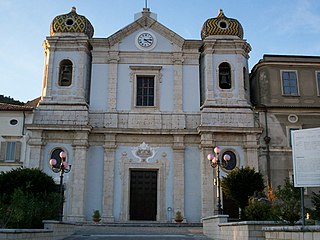
The Diocese of Cerreto Sannita-Telese-Sant'Agata de' Goti is a Latin diocese of the Catholic Church in Campania, Italy, has existed since 1986, when the Diocese of Sant'Agata de' Goti was suppressed, and its territory and Catholic population united to the Diocese of Telese-Cerreto Sannita. The diocese is a suffragan of the Archdiocese of Benevento.
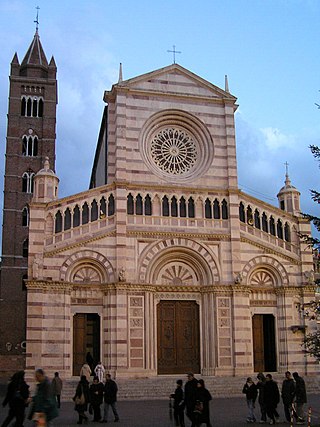
The Diocese of Grosseto is a Latin Church diocese of the Catholic Church in Italy, a suffragan of the archdiocese of Siena-Colle di Val d'Elsa-Montalcino, in Tuscany. Its current bishop is Giovanni Roncari, OFMCap.

The Diocese of Bovino is a Latin Church diocese of the Catholic Church in the civil province of Apulia, southern Italy. It is 23 mi southwest of Foggia. It was established in the tenth century, and was a suffragan of the archdiocese of Benevento. In 1986 it was merged into the Archdiocese of Foggia-Bovino. In 1980, the diocese claimed 23,500 adherents, served by 26 priests.

The Diocese of Nocera Umbra was a Catholic diocese in Umbria, Italy.
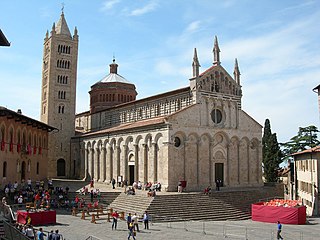
The Diocese of Massa Marittima-Piombino is a Latin Church diocese of the Catholic Church in Tuscany, central Italy. It was known as Diocese of Massa Marittima before 1978. Up until 1458, it was a suffragan of the archdiocese of Pisa; since 1458, it has been a suffragan of the Archdiocese of Siena. The territory of the diocese includes the islands of Elba and Pianosa, and Capraia.
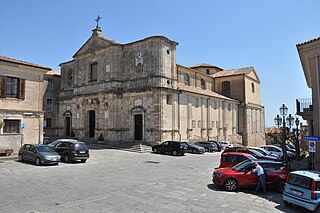
The Diocese of Squillace was a Latin Church ecclesiastical jurisdiction or diocese of the Catholic Church in Calabria, Italy. The diocese was established in the 5th century, and suppressed in 1986. In that year, it was combined into the Archdiocese of Catanzaro-Squillace. It was a suffragan of the archdiocese of Reggio in Calabria.
The Italian Catholic diocese of Bertinoro existed from 1360 to 1986. In that year it was merged with the diocese of Forlì to create the diocese of Forlì-Bertinoro.
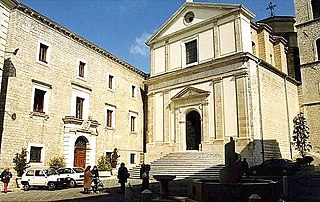
The Archdiocese of Potenza-Muro Lucano-Marsico Nuovo is a Latin diocese of the Catholic Church in Basilicata, southern Italy, created in 1986. In that year the Diocese of Muro Lucano was united into the Archdiocese of Potenza e Marsico Nuovo, which had been elevated to an archdiocese in 1973, and made a metropolitan see in 1976. The historical Diocese of Potenza was united with the Diocese of Marsico Nuovo in 1818.

The Diocese of Conversano-Monopoli is a Latin diocese of the Catholic Church in Apulia. It has existed since 1986, when the diocese of Monopoli was united with the historic diocese of Conversano. The diocese is a suffragan of the Archdiocese of Bari-Bitonto.
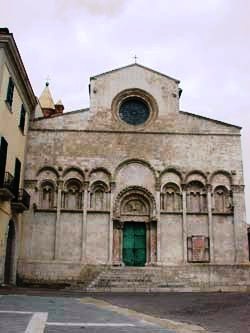
The Diocese of Termoli-Larino is a Latin Church diocese of the Catholic Church situated in the province of Campobasso, region of Molise. The commune of Termoli is an important regional seaport. The diocese has existed in its current configuration since 1986, when the diocese of Larino was suppressed and added to its territory. It is a suffragan of the archdiocese of Campobasso-Boiano.

The Diocese of San Severo is a Latin diocese of the Catholic Church in Apulia. It is a suffragan of the Archdiocese of Foggia-Bovino.

The Diocese of Trieste is a Latin diocese of the Catholic Church in the Triveneto. It has existed since no later than 524, and in its current form since 1977. The bishop's seat is in the Cathedral Basilica of Saint Justus Martyr. It is a suffragan of the Archdiocese of Gorizia.

The Diocese of Pozzuoli is a Latin diocese of the Catholic Church in Campania, southern Italy. It is a suffragan of the Metropolitan Roman Catholic Archdiocese of Naples, like its other neighboring dioceses, Aversa and Ischia.
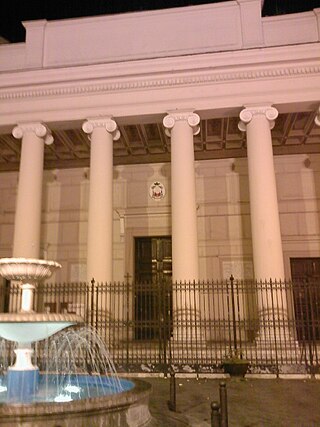
The Diocese of Acerra is a Latin diocese of the Catholic Church in Campania, southern Italy, eight miles east of Naples, in the area once called Terra Laboris (Liburia). It has existed since the 11th century. It is a suffragan of the Archdiocese of Naples.

The Diocese of Sessa Aurunca is a Latin diocese of the Catholic Church in southern Italy. Since 1979 it has been a suffragan of the Archdiocese of Naples.
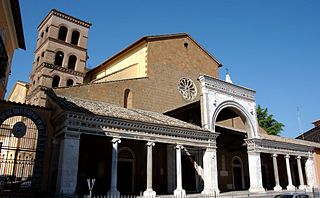
The Diocese of Civita Castellana is a Latin Church ecclesiastical territory or diocese of the Catholic Church in Latium, central Italy. It has existed in the current form since 1986, when the Diocese of Nepi e Sutri was united into the Diocese of Civita Castellana, Orte e Gallese. The Diocese of Gallese had been added to the Dioceses of Civita Castellana and Orte in 1805. The name of the diocese was shortened in 1991, in accordance with Vatican policies. The diocese of Civita Castellana is immediately exempt to the Holy See.

The Diocese of Guardialfiera or Diocese of Guardia was a Roman Catholic diocese in Italy. The diocese was established in the second half of the 11th century, with seat of the diocese was located in the city of Guardialfiera in the Province of Campobasso in the region of Molise. In 1818, the diocese was suppressed, and its ecclesiastical territory was assigned to the Diocese of Termoli.



















